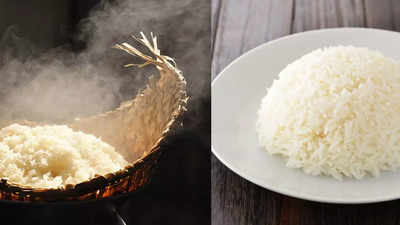Trending
Which is healthier? Regular rice vs sticky rice
Regular rice and sticky rice differ in texture, taste, and uses. Regular rice, with a fluffy texture, suits a variety of dishes, while sticky rice, which clumps together, is ideal for dishes like sushi and Southeast Asian cuisine. Nutritional values, cooking methods, and origins also vary.
Rice is one of the most loved staples across the world, especially in Asian countries for its entcing taste, texture and potent benefits. Interstingly, when it comes to rice, two popular varieties often stand out: regular rice and sticky rice. While both are staples in many cuisines worldwide, they differ in texture, taste, and culinary uses. Let's take a closer look at these differences and explore which one might be better depending on your needs.
Texture and Stickiness
Regular rice, often referred to as long-grain or medium-grain rice, has a fluffy and separate texture when cooked. It doesn’t clump together, making it ideal for dishes like pilafs, stir-fries, and as a side to curries. Sticky rice, on the other hand, is known for its ability to clump together due to a higher starch content, specifically amylopectin. This makes it perfect for dishes where the rice needs to stick together, such as sushi or Southeast Asian foods like Thai sticky rice.
Types and Varieties
Taste and Flavor
Regular rice tends to have a more neutral flavor, allowing the other components of the dish to shine. Sticky rice has a slightly sweeter, more nutty taste that complements certain dishes, particularly in Asian cuisines. Its inherent flavor makes it a standout when paired with savory or sweet accompaniments, such as mango in Thai sticky rice desserts.
Nutritional Profile
Both regular rice and sticky rice are primarily composed of carbohydrates, with sticky rice being slightly higher in calories due to its starch content. While white rice (a common form of regular rice) offers limited nutrients, brown rice provides more fiber, vitamins, and minerals. Sticky rice, on the other hand, is often considered less nutritious than brown rice since it’s usually processed and stripped of the bran.
Culinary Uses
Regular rice is versatile and used in countless dishes worldwide. It can be boiled, steamed, fried, or even baked. It pairs well with a wide range of proteins, vegetables, and sauces. Sticky rice is more specialized in its uses; it is a key ingredient in Asian cuisine, particularly in Thai, Lao, and Vietnamese dishes. It is often served with grilled meats, curries, or used in desserts.
Cooking Methods
The cooking methods for regular rice and sticky rice differ significantly. Regular rice is typically cooked by boiling or steaming, and the cooking time varies based on the type. Sticky rice, however, needs to be soaked for several hours before cooking and then steamed, not boiled. This preparation method ensures the rice retains its sticky, chewy consistency.
Regular Rice vs. Sticky Rice: Origins
The origins of regular rice and sticky rice are closely tied to the regions where they are most commonly cultivated and consumed. While both types of rice belong to the Oryza sativa species, they have distinct historical and geographical roots.
Regular Rice (Long-Grain and Medium-Grain) Origin
Regular rice, particularly varieties like long-grain and medium-grain, has its origins in different parts of Asia, with widespread cultivation in India, China, and Southeast Asia. The cultivation of rice dates back over 10,000 years, with some of the earliest evidence of rice farming found in ancient China and the Indian subcontinent. Long-grain rice, like Basmati, is believed to have originated in the Indian subcontinent, while varieties like jasmine rice trace their roots to Thailand. These regular rice varieties spread to other regions, including the Mediterranean and eventually the Americas, due to trade and colonization.
Sticky Rice
Sticky rice, also known as glutinous rice or sweet rice, is believed to have originated in Southeast Asia, particularly in regions such as Thailand, Laos, Cambodia, and Myanmar. The term "glutinous" refers to the high starch content, specifically amylopectin, that makes it sticky when cooked. Sticky rice is often associated with the agricultural practices of these regions, where it is grown in paddies and harvested for both savory and sweet dishes.
Sticky rice has been a staple in Southeast Asian countries for centuries, and it has cultural significance, especially in Thailand and Laos. In these countries, sticky rice is often eaten by hand, served with grilled meats, or paired with tropical fruits like mango. It also plays a central role in many traditional ceremonies and festivals.
Which Is Better?
The answer to which rice is better?
really depends on what you’re making. Regular rice is better suited for a wider range of dishes and provides a versatile base that can pair with almost anything. It’s especially good for meals where the rice should remain separate and fluffy. Sticky rice, on the other hand, shines in dishes that require the rice to clump together. If you’re preparing authentic Asian cuisine or need rice for a specific texture (like sushi or sticky rice with mango), sticky rice is the better choice.
End of Article
FOLLOW US ON SOCIAL MEDIA
Visual Stories
Tired of too many ads?go ad free now










